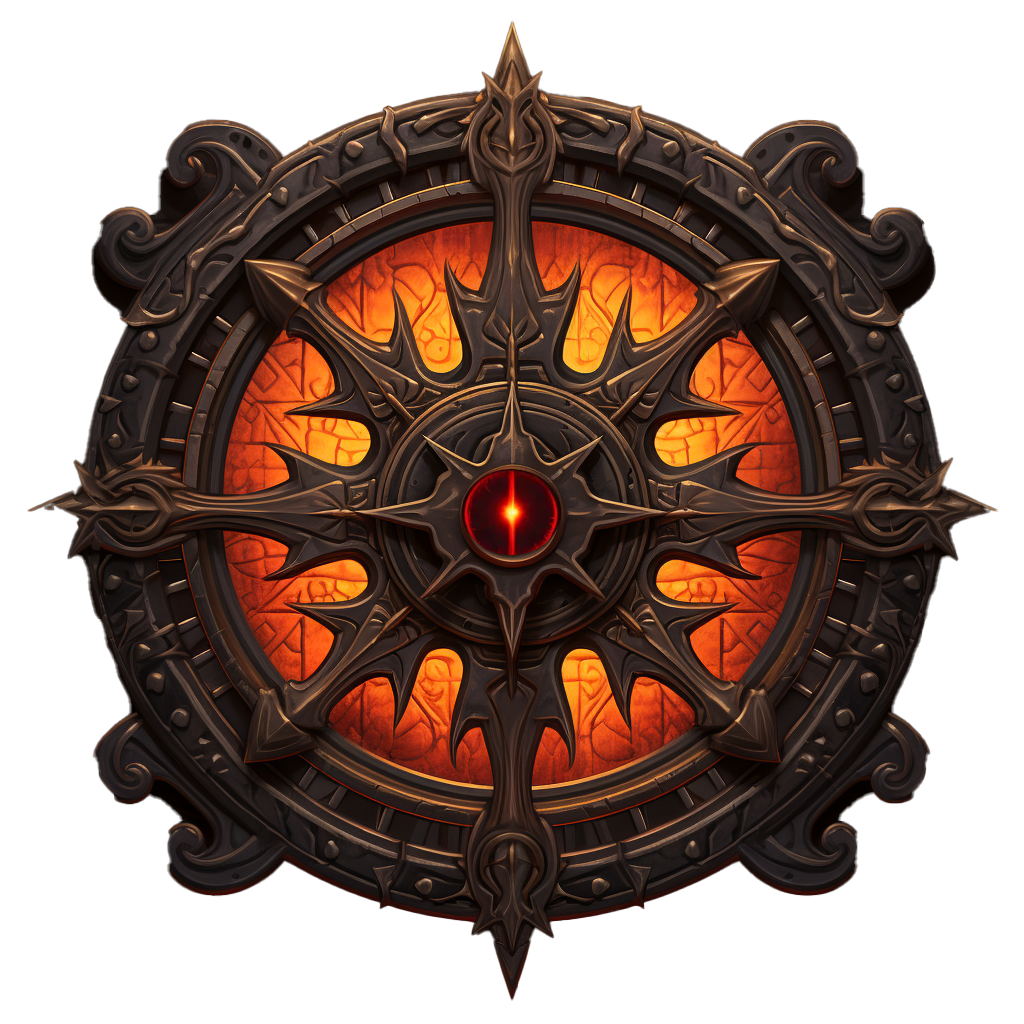The Content of Article
- 1. What is Returning 2.0 Mod for Gothic 2
- 2. Returning 2.0 Alternative Balance (2018) vs New Balance (2021)
- 3. Gothic 2 Returning 2.0 Key Features
- 4. New Gameplay Mechanics
- 5. Karma System and Divine Gifts
- 6. Guilds and Quests
- 7. Returning 2.0 Installation Guide
- 8. Returning 2.0 Some Tips for New Players
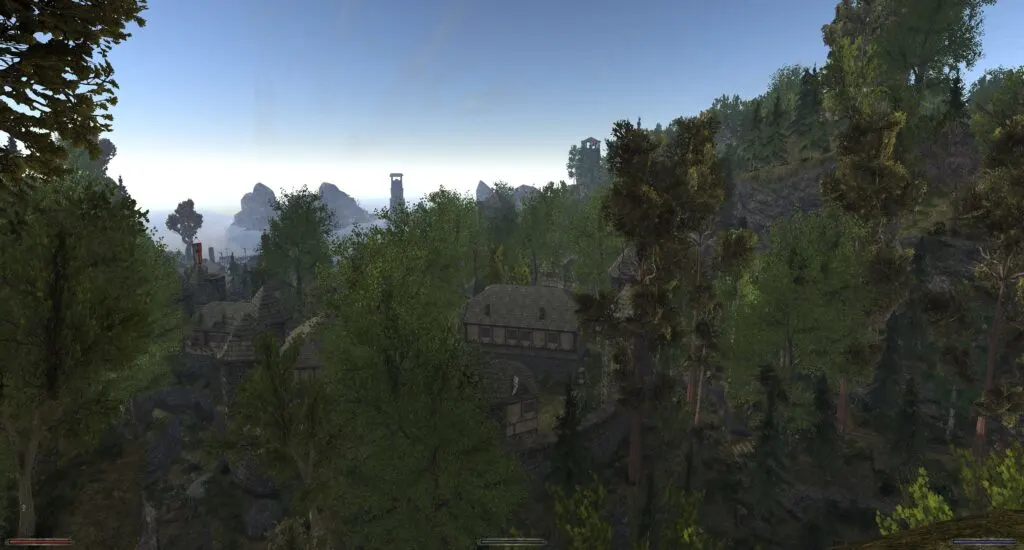
In 2002, German game studio Piranha Bytes released one of the greatest RPG classics, Gothic 2. Hardcore gamers liked the challenging Night of the Raven add-on, which redefined the character development system and expanded the isle of Khorinis to include Jharkendar, an ancient lost city.
After Gothic 3, Piranha Bytes went on to their Risen series and ELEX. Gothic 2 wasn’t officially updated since 2003 when Night of the Raven came out. However, Piranhas released the Gothic Mod Development Kit, allowing the most dedicated and knowledgeable fans to create their own expansions. This is how Returning was born.

What is Returning 2.0 Mod for Gothic 2
Returning 2.0 (Russian: Возвращение) is a huge unofficial expansion for Gothic 2: Night of the Raven made by a team from the Russian modding community. It aims to make Gothic 2 a bigger and even more exciting experience by allowing you to join new guilds and introducing game mechanics not present before, including unique boss fights and rewards. The mod adds new dungeons and regions, and many old locations have been redesigned.
The final version of the Returning 2.0 was released in 2016 on RPG Russia:
https://rpgrussia.com/threads/ssylki-na-sborku-instrukcija-po-ustanovke-…
You can also find it on World of Players: https://worldofplayers.ru/threads/39914
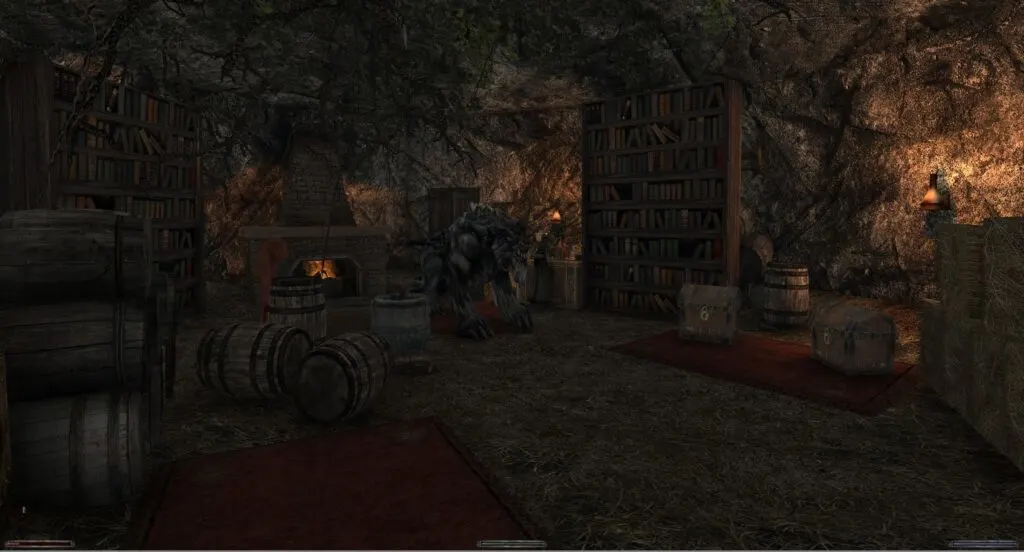
The mod has a long story, starting as early as 2008. Since then, it endured much change: lots of gameplay features were added or altered, new voiced characters were introduced, locations were created from scratch, quest lines spanning the whole game appeared, and so on.
Tons of new equipment have been introduced, including spears, shields, helmets, mage swords that require mana to wield, and much more. Rare plants like King’s Sorrel are hidden in new places, and many common plants and herbs can be used in new recipes.
For seasoned Gothic gamers, the mod offers extreme difficulty settings with boosted enemies and reduced experience rewards. However, you don’t have to stick to hardcore playstyle: you can choose to receive 15 or more learning points per level and additional health boost on level-up, as well as decrease monster defense values. Still, whatever you choose, Returning remains a Gothic game: nothing will be too easy for the Nameless Hero.
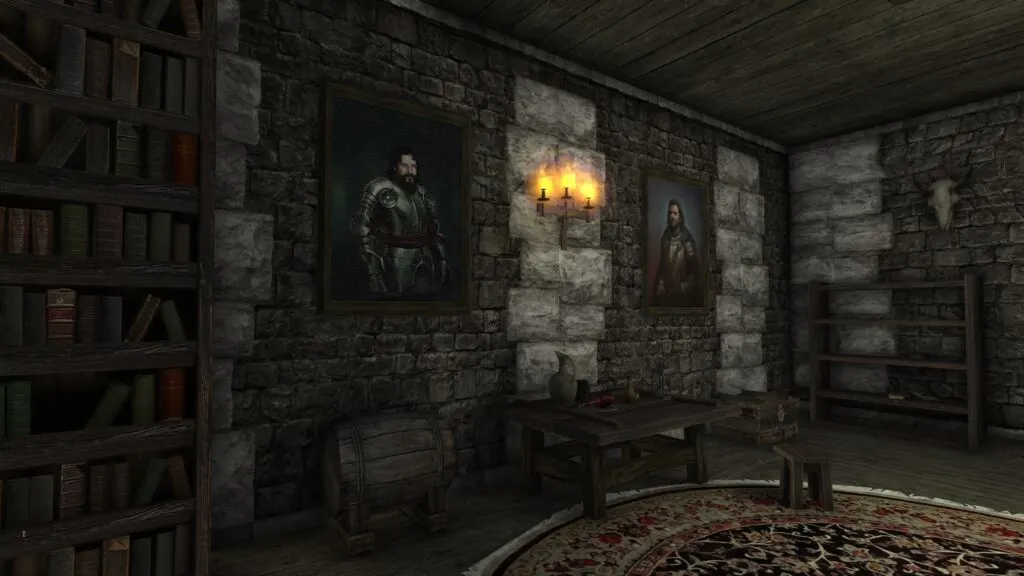
Returning 2.0 Alternative Balance (2018) vs New Balance (2021)
Shortly after release, Returning was revised with the Alternative Balance add-on, developed by a team of five dedicated mod builders. They aimed to make the gaming experience less demanding on the player while also preserving the original challenge. In Alternative Balance, character development depended highly on boosting items you collect and craft, like stone tablets of the Builders and permanent potions.
Returning 2.0 New Balance
In 2020, the Alternative Balance team revised Returning once again, introducing the New Balance add-on. Currently, they continue working on it to further perfect game balance and character building. The team made some changes to locations and introduced a new guild – Dark Knight. As a Dark Knight, you have access to guild-specific weapon buffs and the powerful Minion, a unique summoned creature.
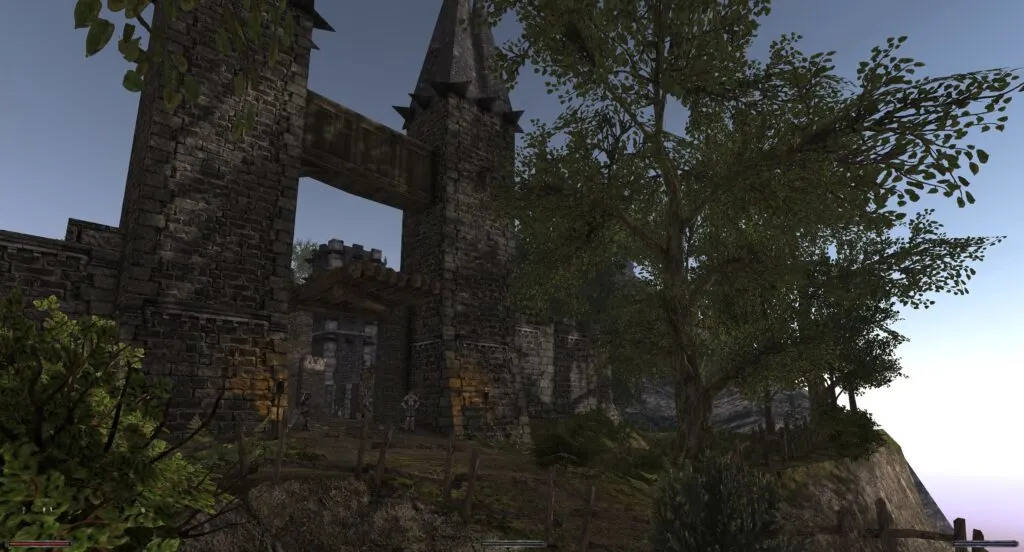
In New Balance, you don’t have to worry about learning points cost for attributes and skills: it remains the same regardless of how many bonuses you have used for your character. Training thresholds are eliminated: originally, you needed 2 learning points to increase your attributes between values 30 and 60, 3 points from 60 to 90, and so on. Now it’s 1 point all the way. This eliminates one highly controversial feature: in Night of the Raven, players tended to save their permanent potions and other boosting items for late-game in hopes of achieving the highest attribute values possible while missing out somewhat on mid-game character viability.
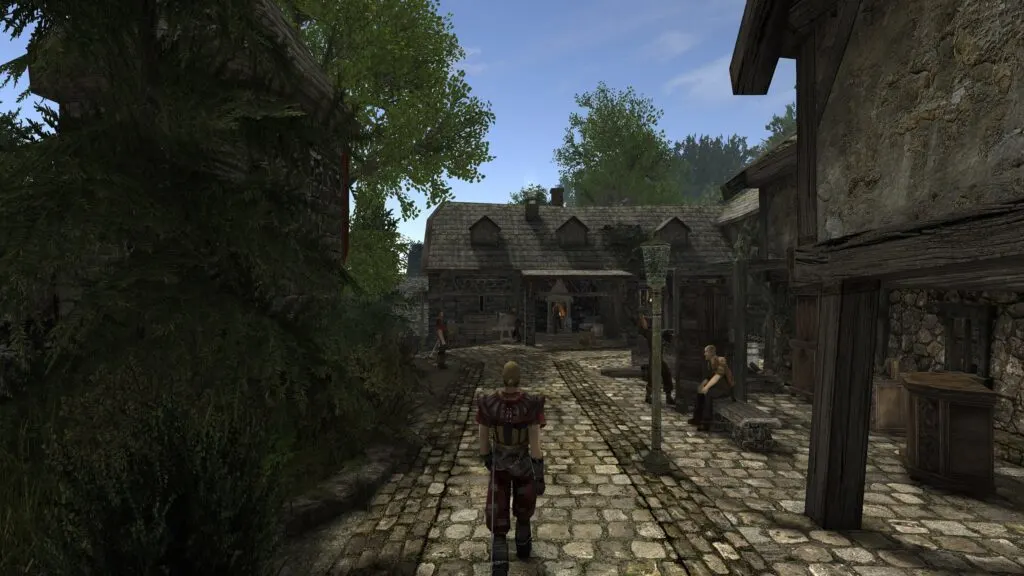
Every training requires gold in addition to learning points. This makes collecting coins just as important as gathering experience, prompting players to learn gold mining, hunting trophies, pickpocketing and other money-making skills you never really needed in the original game. For example, you need 10 000 gold coins to learn mana regeneration, a very important step for mage builds. Of course, you don’t need such amounts for increasing your mana pool or strength training.
Gothic 2 Returning 2.0 Key Features
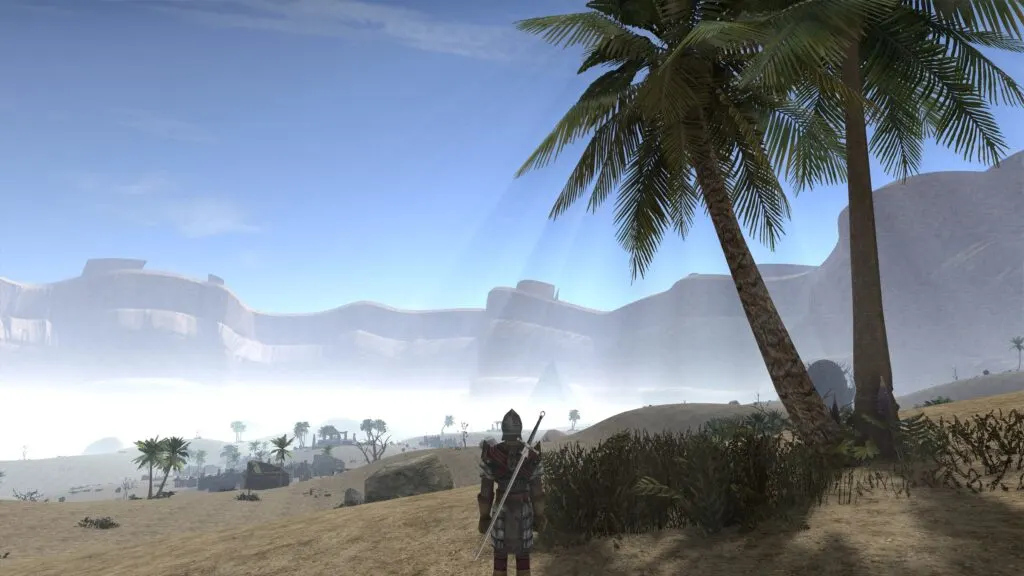
The game has been hugely updated in all respects. You’ll see a lot of new NPCs (including more fellow prisoners from Gothic 1), quests, new locations and a great selection of new weapons and magic spells, along with new character building options. Old locations like the harbor city of Khorinis have been remastered: you’ll see new streets and passages, Constantino the Alchemist now has a cozy dwelling above his laboratory, Vatras the Water Mage has a house, too, and much, much more other changes to the city and the whole island. A vast woodland area has been added to the north of Onar’s farm where you’ll meet a druid living in a cave who can teach you to craft poisons.
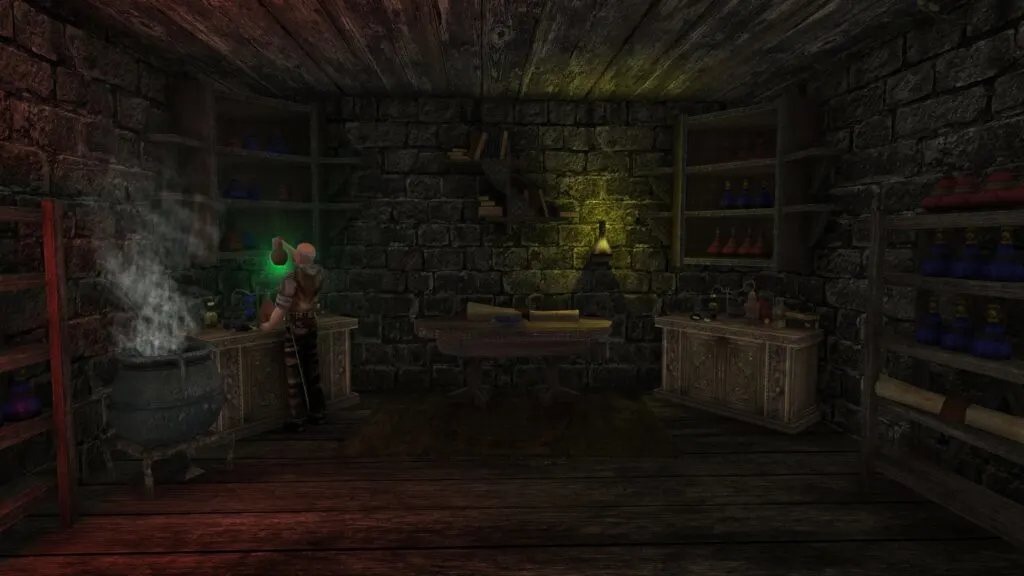
New locations include the Hidden Valley of Ashtar in Jharkendar, Plateau of the Ancients where you’ll explore a huge desert realm to find forgotten artifacts and learn more about the people of Jharkendar, Paladin Fort Azgan, and much more. Also, you’ll revisit the Temple of the Sleeper from Gothic 1 when you reach the Valley of Mines.
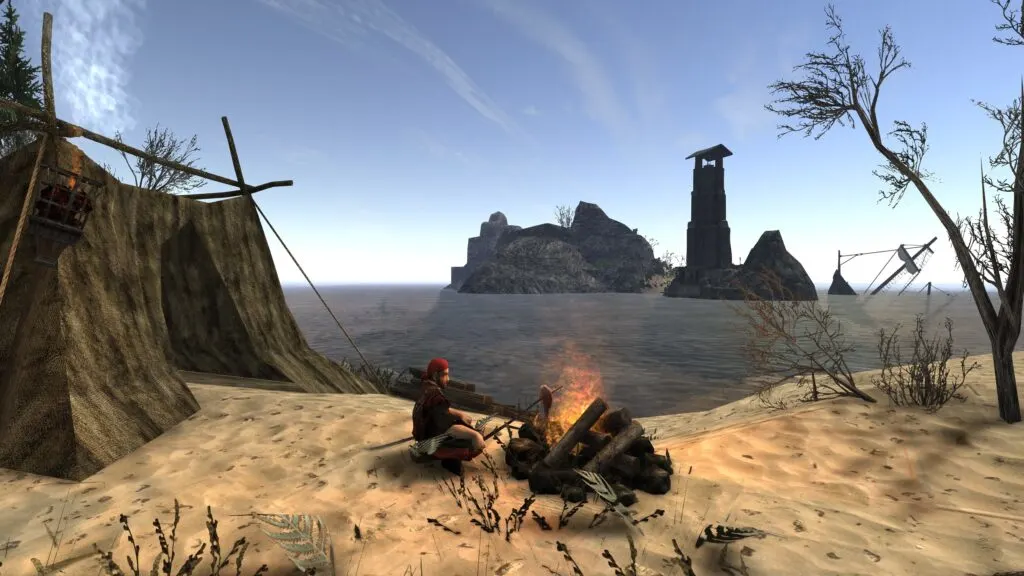
Returning 2.0 has optional built-in graphics enhancements you see on the above screenshots. You can enjoy Gothic 2 on modern PCs with DirectX11 Renderer: updated visuals, lush vegetation, new blood textures, dynamic lighting and overall great looks for the classic RPG from 2002.
The game received an additional story chapter. Overall playthrough time is estimated to be 250+ hours, provided you explore all locations, collect all stuff, talk to people, and complete side quests. Of course, you can finish the game and build a powerful character much faster.
New Gameplay Mechanics
Many gameplay-related things were altered, and new features were added. Building your character in Returning is a much more diverse experience than it was in the original game, with possibilities for creating an ultimate mage viable in the early game, tanky sword-and-board warrior, or agile fighter with deadly dual wielding skills; not to mention other traditional builds and all sorts of hybrid classes. You can even choose to specialize in poisons, but it’ll weaken your direct physical damage output.
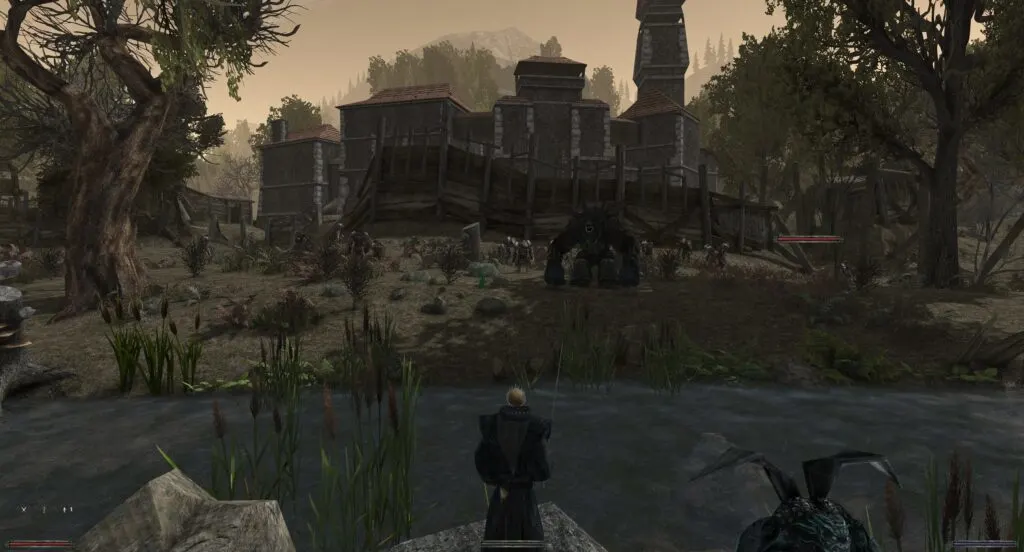
Updated Magic System
Magic has been revised a lot. Fire mages are now truly fearsome: each subsequent attack lowers enemies’ resistance to fire and makes them burn even better. Water mages now can randomly freeze enemies with their offensive spells. Frozen enemies suffer much more damage from Water spells. Necromancers have access to a unique demon servant and powerful offensive spells which randomly deal critical damage. And on top of that, you can play as a Guru of the Swamp Brotherhood. Gurus have great crowd-control spells and ranged poison attacks.
Mages now have their specific attribute: intelligence. It defines your magical power and influences the rate at which your mana regenerates, but you can’t invest your learning points into it. You have to read books or perform other specific actions to increase it.
Another important change for mages: usually, you have to learn runes from lower magic Circles to access their better versions from the next Circles. To craft a Fireball rune, you must learn Fire Arrow. Besides, you’ll need a definite amount of mana to step into the next magic Circle, like 450 for the third or 650 for the fourth.
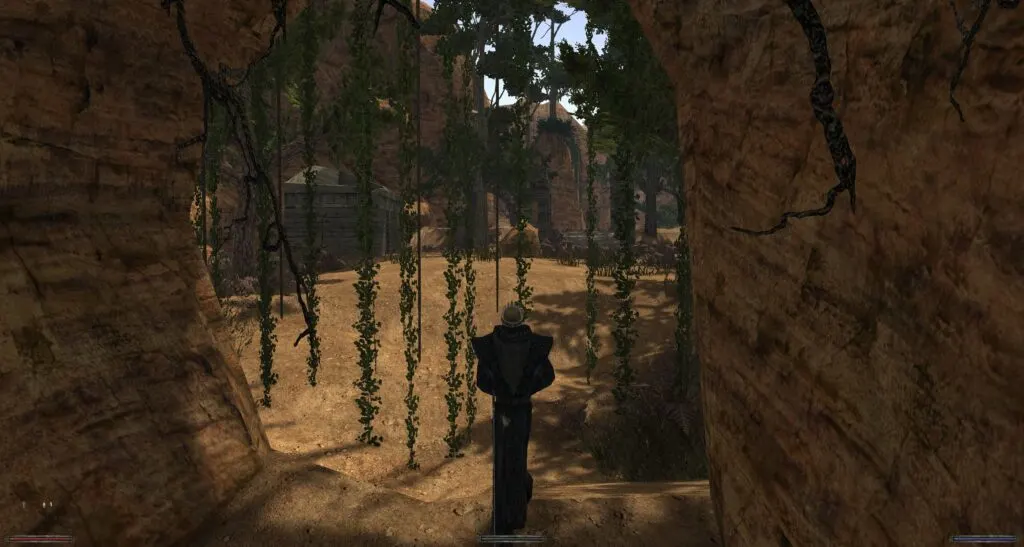
The summoning system is way different from what it was back in the original game. The new summoning limit doesn’t allow you to conjure up a whole army, but your summoned creatures will stay around until they die in combat or if you choose to release them. Each summoned creature drains your mana over time, even more so when in a fight. It’s possible to offset it by learning mana regeneration: the greater your mana pool and intelligence, the faster your mana regenerates, and soon you’ll be able to keep creatures around for as long as you wish.
Combat Redefined
The Nameless Hero now has stamina in addition to health and mana. Just like in Gothic 3, you can use it to sprint, jump and fight. When it reaches low values, your attacks become slower, the mana regeneration rate decreases and your attacks do less damage. You can increase your stamina like any other attribute by training or consuming permanent elixirs. The same is true for health: you can now use learning points to increase it directly.
Damage subtypes were introduced: you’ll deal more damage to skeletons and stone guardians if you fight them with blunt weapons, and your dark magic won’t be as effective against undead enemies as banishing spells or fireballs.
In addition to that, damage-over-time effects like bleeding, burning and poison were implemented.
Combat has become more dynamic: you can sprint to close up quickly, hit multiple enemies at once with melee weapons, and arrows always damage the target if they actually hit. In the original game, your chance to damage enemies depended on your skill with either bow or crossbow. In Returning, your skill values decide which ranged weapons you can equip: the higher it is, the better bows and crossbows you can use. Besides, you can now move around while shooting or drawing your bow.
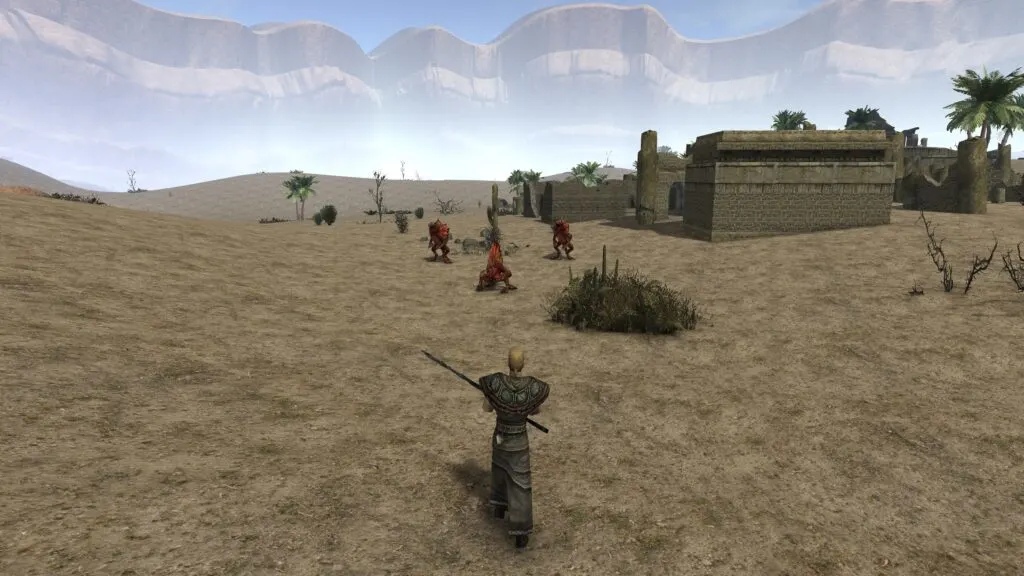
Some combat animations have been tweaked, and new movesets appeared, like sword-and-shield fight style. Blocking attacks with two-handers became easier and faster, and fighting animation for combat staves is different from two-handed swords.
Numerous Minor Changes
The crafting system is now more diverse: you can make your own arrows and crossbow bolts (including fire arrows, magic arrows etc.), or use hunting trophies like fire lizard tongues to brew powerful potions. The hunting skills are now way more important, and learning them is actually a must for every character: if nothing else, you can sell all trophies at the Hunters’ camp for a nice price.
Chest unlocking is different depending on your character build. Now, you don’t have to learn lockpicking to get the treasure. As a warrior, you can force open chests if you have enough strength, and mages have access to an “open locks” spell.
The devs also made HUD updates: you can customize it to show day time, Karma points and other things. You can now turn on damage display for both dealt and received damage, useful for judging your combat efficiency with various gear.
Karma System and Divine Gifts
In Returning 2.0, the Nameless Hero receives Karma points for specific actions. If you steal things or murder people, you increase your Beliar Karma. The dark god will also favor you for certain actions during quests, like cheating people for your own gain. Innos will reward you for being just and helping people.
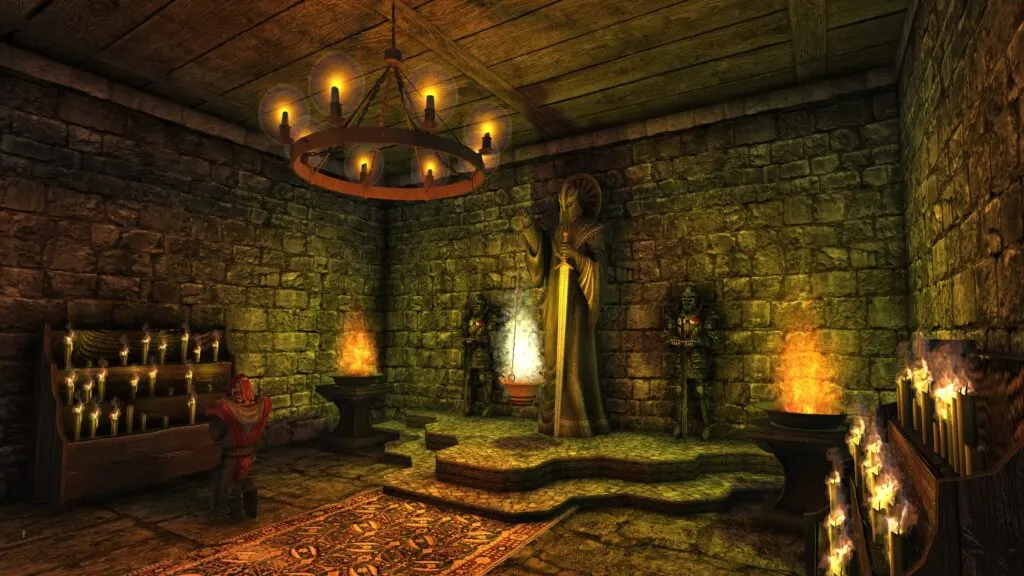
With both gods, you can make donations and pray regularly to get additional Karma points. You can spend these points to choose divine gifts: Innos or Beliar will increase your strength, mana pool, magic power and so on, or provide unique benefits like a magic shield on being attacked.
Note that you can’t receive Innos gifts if you play as a Necromancer, and you can’t be favored by Beliar if you’re a Paladin.
Guilds and Quests
Returning brings new guilds you can join. Right at the beginning, you can ask Xardas to teach you necromancy, or you can become a Novice by the Water mages. Other options include joining the remnants of the Swamp Brotherhood from Gothic 1, now found near the entrance to the Valley of Mines in Khorinis. The newest addition is Dark Knight, accessible after you complete the first quest issued by Lothar, the first Paladin you meet in Khorinis. Old guilds are still available, of course, with certain tweaks like diversified Paladin magic.
Numerous minor guilds appeared: you can now join the Hunters’ camp, become a member of Traders’ faction in Khorinis, or earn some quick money with Assassins. You already had the Thieves’ Guild, Pirates and Ring of Water in the original game; now, even more questlines were added. Be wary, though: completing quests for Assassins is a sure way to lose your Innos Karma, and you can’t join them once you are a Fire Mage or a Paladin.
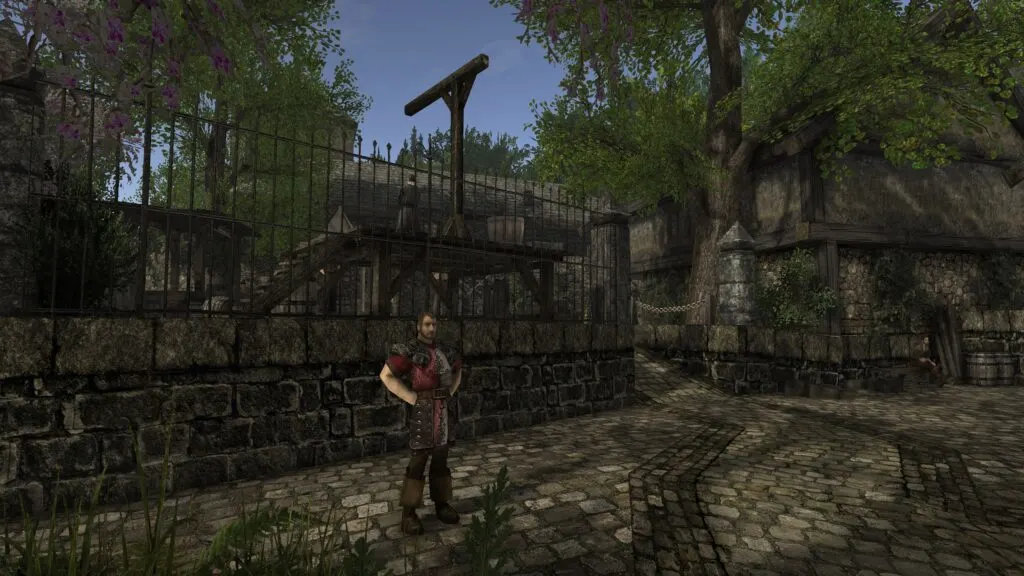
Apart from guilds, numerous extra quests and NPCs appeared throughout the world, with new options in the existing quests. Becoming an apprentice in Khorinis is a much more difficult task now: you’ll need Pablo’s help even to get them to speak to you. With each master, you now have more benefits. Constantino will buy unneeded permanent elixirs you find and pay a nice price for specific animal trophies like bloodfly stingers and wings, and Bosper will help you join the Hunters easily.
Returning 2.0 Installation Guide
In this section, we’ll guide you through a somewhat tricky process of mod installation. Don’t worry: it’s not much different from installing the game itself.
You’ll need Gothic II Gold Edition from Steam. If you don’t have a Steam version, make sure your game is patched to 2.6, and you have the Night of the Raven expansion installed.
First of all, installation guide from Returning Mod Team (in Russian): https://rpgrussia.com/threads/pravilnaja-ustanovka-vozvraschenija-2-0.14676
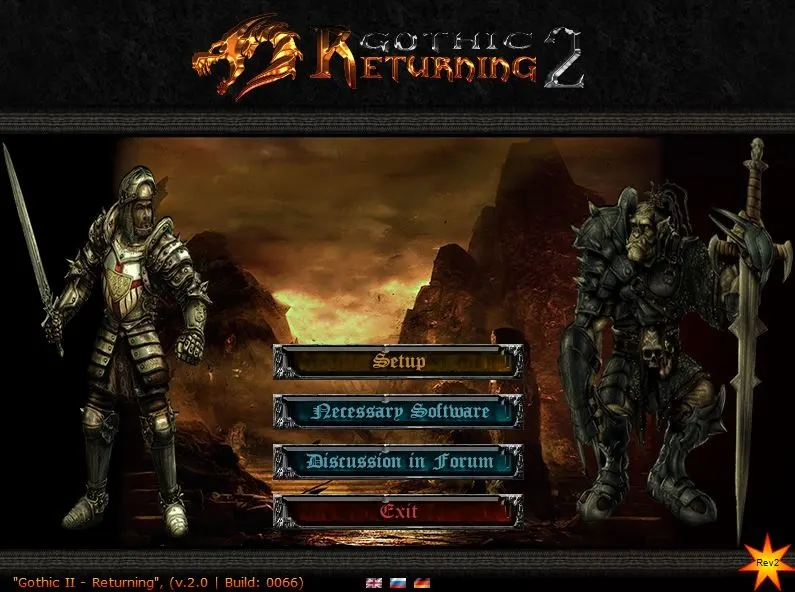
Here’s what you need to do:
Download and install the vanilla mod Returning 2.0 (Use Ret.exe): https://drive.google.com/file/d/1VjWOUBzOZddeNKZEgMR3ZYZb160hEDKP/view
How to install Returning 2.0:
First, in the Necessary Software menu, install the software in the order recommended by the Returning Mod Team:
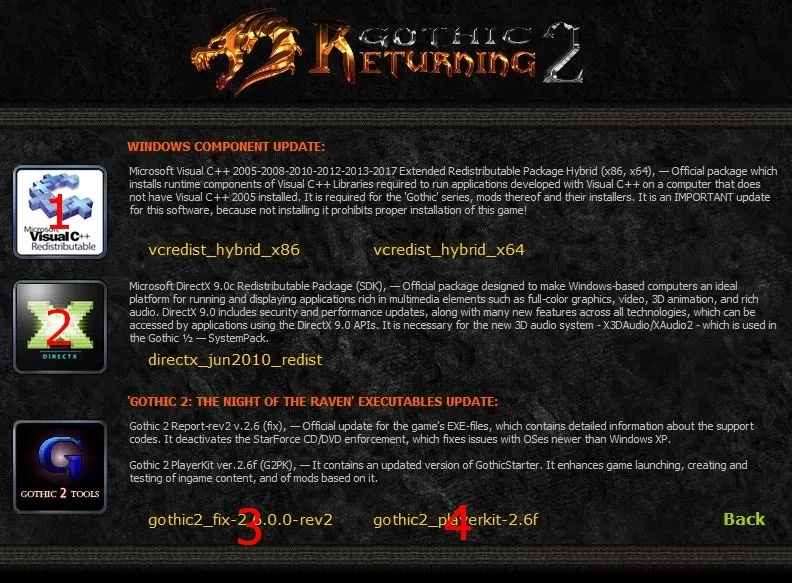
Then, proceed to the Setup menu and make sure to check these boxes (recommended by the Returning Mod Team):
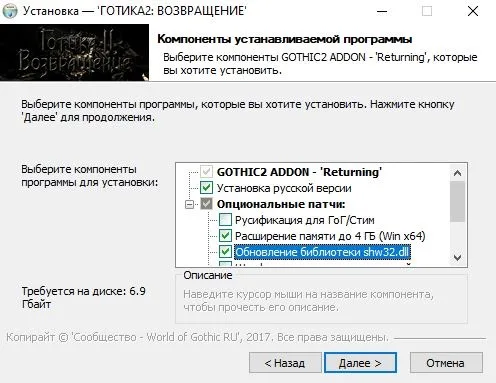
- “Установка русской версии” – Russian localization. It is needed for the mod to function properly. Later, you can install English Patch.
- “Расширение памяти до 4 ГБ (Win x64)” – Increase memory limit to 4GB (4GB RAM Patch).
- “Обновление библиотеки shw32.dll” – Update shw32.dll library.
Optionally, choose:
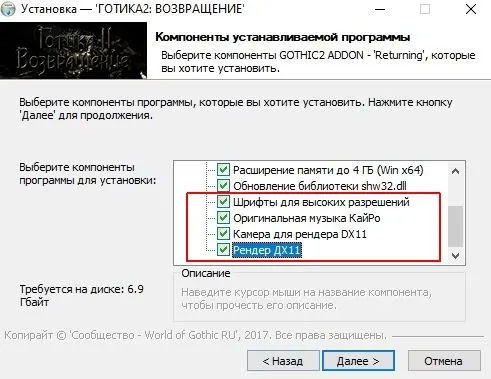
- “Рендер ДХ11” – DirectX11 Renderer; it’s a whole new look for the classic Gothic 2 with high-resolution textures and dynamic shadows.
- “Камера для рендера ДХ11” – alternative camera view for the DX11 Renderer.
- “Оригинальная музыка КайРо” – original soundtrack by Kai Rosenkranz. The game soundtrack has been expanded, but you may want to stick to the original exploration and ambient tracks.
- “Шрифты для высоких разрешений” – Hi-Res fonts for running Gothic 2 at high resolutions on modern displays. With Cyrillic fonts, it works fine. If you experience any problems after installation in English, uncheck it.
Download and install New Balance add-on with latest scripts by placing it in the game folder (agree to replace all files): https://drive.google.com/drive/folders/1LaS66JrJfCghx8Dy4B30jAazGgn7pYf8
Note that the mod team may roll out updated scripts at any moment. Usually, you don’t have to start a new playthrough: download & replace once again, or continue with old scripts. You can find the full New Balance changelog list here (in Russian): https://docs.google.com/spreadsheets/d/1ALthCeaOsNWvxolgGZTqcGD6hvYWYu0s...
Usually, changes are about bug fixes and minor balance tweaks, but content updates are also possible.
Install English Patch: https://upload.worldofplayers.de/files10/RET2_0066Rev2.1_googlepatch.exe…
Note that this is not a “proper” translation, so you’ll probably run into some language barrier issues. Feel free to ask the community on https://rpgrussia.com/forums/gotika-2-vozvraschenie-2-0-novyj-balans.517 for help and clarification.
If you decide to play with DirectX11 Renderer, you can further configure your graphics in-game: press F11 and Ctrl-F11 for advanced settings like small object visibility range, or to adjust brightness.
Returning 2.0 Some Tips for New Players
For the first playthrough of Returning, consider setting a moderate difficulty level with 15-20 learning points per level and 50% monster health. The game will be challenging enough, and you’ll be able to learn the new features without careful character planning.
At the start of the game, make sure you explore Xardas’ tower well. It now has a special balcony where you can conduct a certain ritual to receive an experience bonus and a permanent mana potion.
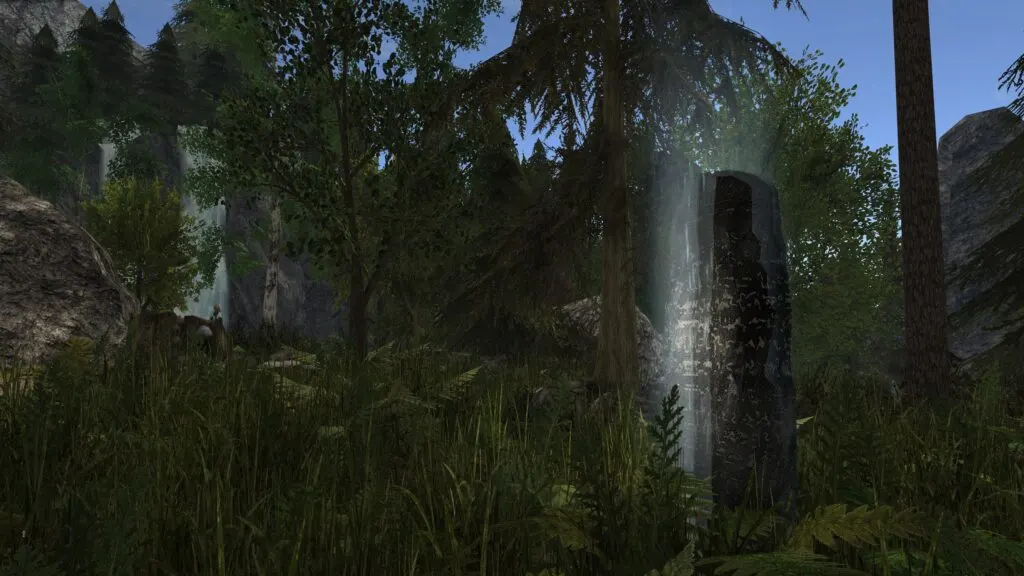
Read all the books you find, starting from Xardas’ tower. Reading will increase your intelligence and rhetoric skill. You can use rhetoric in dialogues to persuade people during quests or to avoid punishment. When you have 10 points in rhetoric, you can borrow 1000 gold coins from Lehmar.
Make sure you check bookshelves, lockers, tombs and similar objects. They now contain valuables, just like chests.
Try getting into the city via swimming into the harbor. Lares will reward you with experience, just like in Night of the Raven.
You don’t have to pay to get citizen’s clothes. Climb into the upper quarter from the marketplace and search the roofs there. Make sure you do it at night. Otherwise, the guards will attack you on sight. Alternatively, use a Sleep scroll on the guard behind Matteo’s shop and get to the chests, just like in Night of the Raven.
Run around, talk to people and complete all the quests which don’t involve fighting before setting out into the wilderness. A wise early-game decision is to put some learning points into one-handed combat (up to 30%), strength, stamina and health. Also, consider investing into mana to be able to use scrolls. All this will help a lot, and you’ll still be able to build any kind of character later in the game.
Become friends with the Thieves Guild. You’ll get much more benefits from them than in the original game. In particular, make sure you’re on good terms with Halvor, the one who sells fish at the harbor.
Avoid fines: beating people or stealing will cost you at least 750 gold coins. Use Sleep and Oblivion scrolls. Buying them is way cheaper than paying huge fines.
Before joining any guild, make donations of 1000 gold coins by Vatras and Daron to Adanos and Innos, respectively: doing so will increase your mana and provide some other benefits.
Put some learning points into stamina: you’ll need it to fight efficiently and sprint away if you run into powerful enemies.
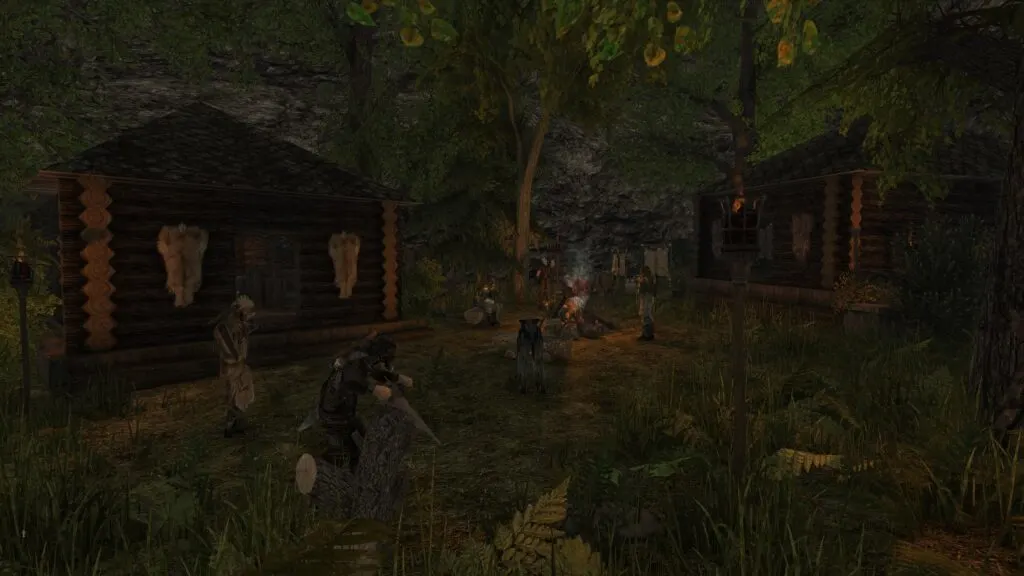
Make sure you learn hunting trophies before killing shadow beasts, fire lizards and other animals with valuable trophies. Fire lizard tongues are particularly important: they are used in recipes to increase your mana pool and fire resistance. If you’re Constantino’s apprentice, he’ll pay you loads of gold for minecrawler mandibles and bloodfly trophies. Feel free to learn all hunting trophies as early as possible, whatever character you play.
Complete all quests issued by Matteo, one of the five masters in Khorinis. As a reward, he’ll teach you to craft rings and amulets with powerful effects like stamina and health regeneration.
Travel around with Lares: just like in Night of the Raven, you can lure bandits and monsters to him when he stands around and waits for your decision to carry on. He easily kills shadow beasts and bandit leaders, and you gain all the rewards. In particular, make sure to visit the woods with Lares when the Water Mages send you on a quest to find ornament pieces: you’ll get tons of experience, and he’ll do all the fighting.
Make sure you complete Gallahad’s quest before you join any guild. Gallahad is the city mage living in the harbor quarter. He can teach you some magic spells even if you don’t belong to a mage guild, and has a nice selection of scrolls for sale. During the quest, you’ll need to talk to Larius, the governor of Khorinis. Wait for him near the city hall entrance between 12 and 14 hours: he’ll come out.
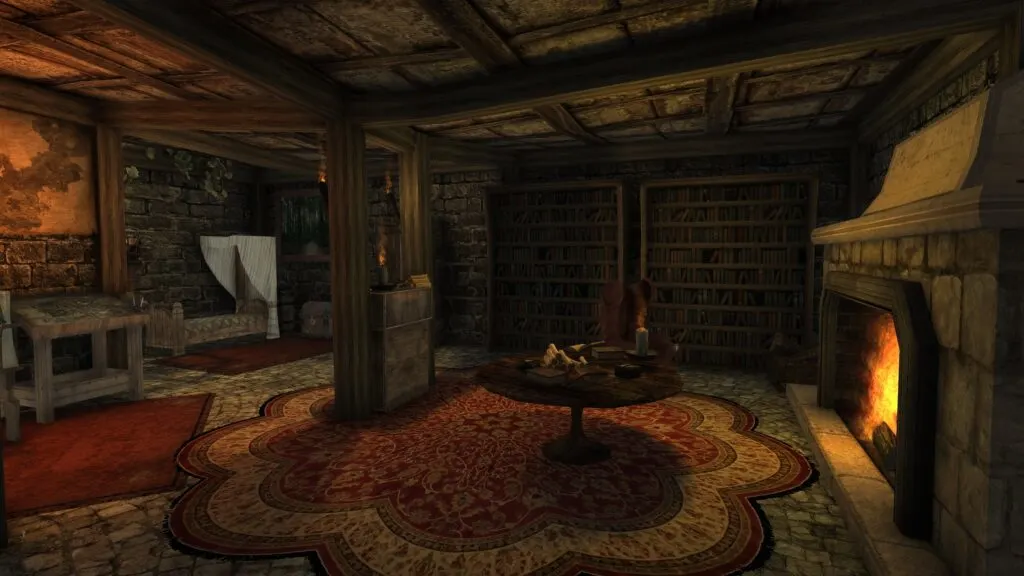
If you decide to become a mage, save 10 000 gold to learn mana regeneration by Vatras or your guild teacher. You’ll need the second magic Circle for the option to appear in the training dialogue. Regeneration will save you loads of potions and make playing as a mage way more enjoyable.
If you decide to help the wounded orc near the city, do so before chapter 2. Salandril sells the healing spell in the upper quarter.
When you get to the Valley of Mines, consider learning the bloodfly rune. You’ll find the teacher for that in the monastery ruins behind the orc wall. When you are transformed, orcs won’t attack you. You can explore and complete quests with ease. Besides, the bloodfly is fast, suffers no fall damage and can glide over the water surface.
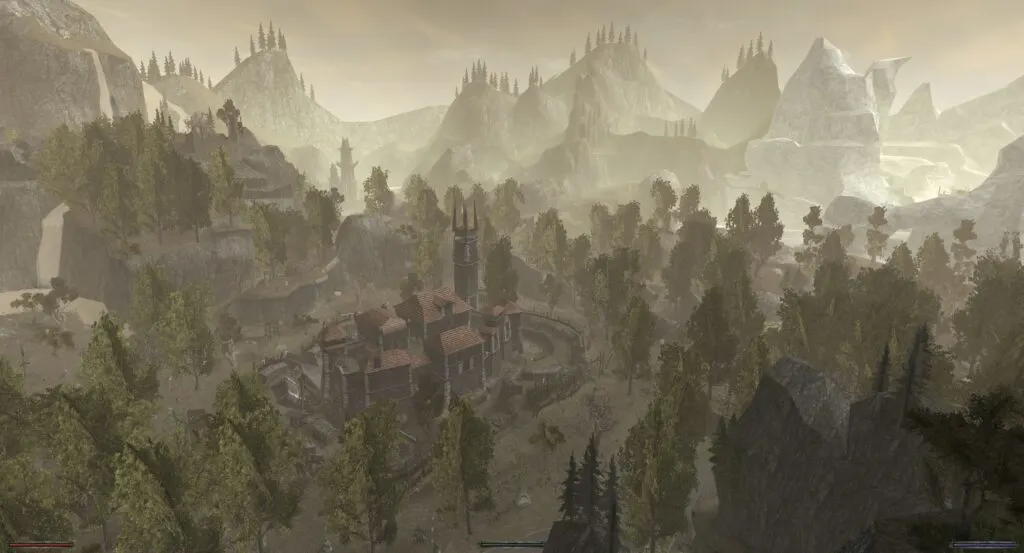
It’s all right to fail or even ignore some quests and not be afraid to choose a “wrong” option during some dialogues. After all, Gothic 2 is an RPG game and not all about maxing out stats. Enjoy your play!
